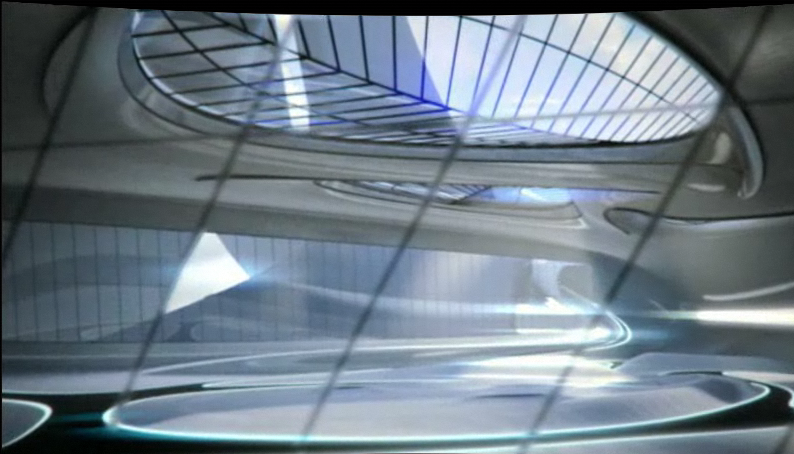Welcome to the first installment of the Social Media Spotlight, our monthly feature focusing on arts organizations’ social media strategies.

Vancouver Opera’s social media presence, headed by photography/fashion buff and technology maven Ling Chan, goes where few opera companies have gone before. In order to achieve their goal of increasing brand awareness and facilitating two way communications with their followers, the $9 million opera company has launched initiatives like manga (a traditionally Japanese style of comic) and an annual animation contest, for instance. Currently on the company’s blog is a serial feature written in the voice of the main character of their world premiere opera, Lillian Alling.
Vancouver Opera takes ideas that many non-profit arts companies might deem risky or unsustainable and, through a combination of sheer creativity, thorough execution and diligent tracking, have made the Vancouver Opera social media sites vibrant, interesting, and unique.
Social Media Manager Ling presented her work this summer at the Opera America Conference. I caught up with her to chat:
Everything in the Vancouver Opera social media presence looks so vibrant. When you first set out, what were your goals for your organization and your audience?
Thanks! Vancouver Opera is a vibrant and innovative company that loves to engage with our community. When we first started out with social media, our goal was to put a face on the organization as well as increase awareness of the art-form of opera through educating and entertaining our tech savvy, minimally to moderately engaged supporters. Vancouver Opera was one of the first arts organizations to really use social media tools. From the start, we were committed to reaching the next generation of opera lovers using the media of the times and integrating it into our marketing/PR mix.
Your summer blog features keep your readers captivated during Vancouver Opera's off-season. Tell me about Opera Mania 101 and the other summer blog features.
During the summer months, we needed to come up with ways to keep our followers engaged, so we came up with some regular features for the blog. • Operamania 101 is a feature I came up with and thought would be helpful for the opera-curious. It’s opera education from a pop culture perspective. Everyone’s heard snippets of opera in movies, TV shows, cartoons and commercials and yet people might think they don’t know opera. They are more familiar with opera than they think. Some other blog features have included: • Bizarre Opera Videos where we post odd, unusual, or notable performances of opera found on YouTube. • Tuesday Trivia where we come up with opera themed quizzes. • Top Ten Lists where we invite readers to vote for their #1 choice. For example: Top 10 Villains, Top 10 Opera Tearjerkers, Top 10 Fantasy Operas • Other features: 20 Questions with an Artist, Everyone’s a Critic, Lunchtime Poll, Opera Props
Lego Carmen, one of the "Bizarre Opera Videos" posted by Vancouver Opera to keep interest in opera during the summer months
You have a background in photography. Was this the impetus for Flickr Fashion at the Opera? What are the goals of the program and what inspired you to create it?
I love taking pictures and I have always had a passion for fashion. I went to fashion design school years ago and worked as an assistant stylist on a couple of magazine and music video shoots. While working down at the theatre during Eugene Onegin in November 2008, I couldn’t help but notice how many young people went all out, dressing themselves “to the nines” for our operas. It wasn’t all just formal wear either. Our audiences mixed dressing up with elements of street, punk and preppy fashion, bringing a whole new flava to the world of opera. The people who dressed up for our operas inspired me to come up with Fashion at the Opera, which you can find on our Flickr.
Describe Blogger Night at the Opera. How did it engage new audiences? Did it show an increase in sales?
Our very first Blogger Night at the Opera was in January 2009 for our Carmen opera. A prominent local blogger named Rebecca Bollwitt, aka Miss 604, came to our Eugene Onegin that previous fall and she ended up blogging about the experience on her own personal blog. We got to talking and she suggested we coordinate a blogger night, which we did and it has since became so wildly successful that other opera companies started calling us to find out how to set it up for themselves.
We invited bloggers who were opera newbies to join us, blogging pre-show and during intermission their thoughts on the opera and the whole experience of being at the opera. We gave them backstage tours and also invited them to mingle with cast, staff and guests at the post-show party on opening night.
We live streamed their web links on our VO blog, so that our readers can follow along in real time. This was great exposure for us and a way of getting the next generation interested in opera. Most of their readers have never been to the opera. But after reading about Blogger Night at the Opera, they became excited about our operas and what we’re doing with social media and bought tickets to the next performances. I had a few of them seek me out on the theatre floor to tell me they were here because of Blogger Night at the Opera.
What's Opera Ninja and how did you come up with the idea? How do other people in the organization feel about giving control of their communications over to (basically) a volunteer?
Opera Ninja evolved from Blogger Night at the Opera. We had blogger night on Opening Night. What should we do for dress rehearsal? We came up with Opera Ninja March 2009 for our Rigoletto dress rehearsal.
It was inspired by Welsh National Opera when they tweeted 12 hours in the life of the Welsh National Opera's The Marriage of Figaro, including a live relaying of the performance (also translated into Welsh).
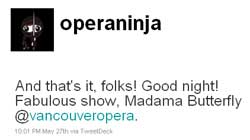 On our dress rehearsal nights, the Opera Ninja would live tweet. Followers were engaged with seeing an event unfold and have an insider view of what was going on behind-the-scenes. The tone of Opera Ninja is cheeky, fun, irreverent. We didn’t necessarily want it to be a play-by-play of what was happening on the stage. Instead it could be the Opera Ninja’s reactions to what was going on. Our followers have found this entertaining and fun. They would add comments and also re-tweet our tweets to their own followers.
On our dress rehearsal nights, the Opera Ninja would live tweet. Followers were engaged with seeing an event unfold and have an insider view of what was going on behind-the-scenes. The tone of Opera Ninja is cheeky, fun, irreverent. We didn’t necessarily want it to be a play-by-play of what was happening on the stage. Instead it could be the Opera Ninja’s reactions to what was going on. Our followers have found this entertaining and fun. They would add comments and also re-tweet our tweets to their own followers.
I was the original Opera Ninja but have since invited our bloggers to take on the character in their own voices. I give a lot of freedom to our Opera Ninjas in what they tweet because I trust them. They are high-profile and active Twitter users. They know the etiquette, the advantages and the drawbacks of Twitter. They understand that they can have fun as the Opera Ninja but as they’re also representing VO for the night, they have to be professional too.
Vancouver Opera has started publishing manga, a comic book based on the opera. Manga is sort of an unusual foray for an opera company to take. What inspired you to take the stories of operas to this new medium?
It may sound like a strange combination but the partnering of opera and manga has worked extremely well for us. We were approached by Vancouver artist & editor Roy Husada of Rival Schools four seasons ago with the idea of “manga-nizing” our operas. It started out in black & white and written in Japanese, but has evolved into colorful mangas in English. The mangas are eye-catching and it helps give readers an idea of what the opera is about, thus sparking their interest in coming to the opera. Our mangas have proven to be very popular with our followers.
By my count you have at least four Twitter accounts for Vancouver Opera. Why? What are the advantages to have many accounts? And how do you track and get a good picture of your audience?
We have 4 Twitter accounts: 1. Vancouver Opera which is our main Twitter account where I tweet daily. It's the one with the most followers and the most activity, so it’s this account where I keep track and measure all our questions, responses and re-tweets.
2. Operabot which was started for our Operabot contest, an animation contest for our Golden Anniversary season. Professional and student animators were challenged to create animated shorts of one of the four productions last year. The tweets posted to Operabot related to updates on the contest, the submissions received and any fun or wacky robots related links.
3. Opera Ninja – We wanted a dedicated Twitter account just for our exclusive “behind the scenes” tweeting during dress rehearsals.
4. Where’s Lillian – For our upcoming world premiere, we wanted to introduce our Twitter followers to Lillian Alling as she makes her epic North American journey from Ellis Island to the wilds of British Columbia. She travels on foot in search of a man named Josef. We have someone taking on the persona of Lillian Alling and tweeting in their own voice the adventures and hardships that the real Lillian Alling might have encountered. From these tweets, we hope that followers will become intrigued with Lillian Alling and want to come to the opera.
Each Twitter account serves a different purpose and we wanted to have a dedicated account for the audience who wanted just Operabot updates or just Opera Ninja updates. Also it frees up our main VO Twitter stream by not bombarding our followers with too many tweets or random-sounding trains of thoughts.
What have been the results of all of these programs for Vancouver Opera? Many times it is difficult to track the effects of social media programs. How have you been tracking your initiatives at Vancouver Opera?
Our social media initiatives have garnered a lot of positive attention from newcomers to opera, opera lovers, our peers in the industry and the media.
I track and report data to measure the impact of our social media efforts in various ways: • Blogger – Google analytics, Like This / Tweet This buttons • Facebook – analytics • I use the Bit.ly shortener for our tweets to see how many people click on our links • Through promo codes in our Tessitura software, I can find out how many tickets were purchased whenever a sales offer was put forth on our social media channels.
Any initiatives for the 2010-2011 season that you'd like to preview for us?
I have some exciting things planned but it’s a surprise. Everyone will just have to stay tuned to Vancouver Opera.






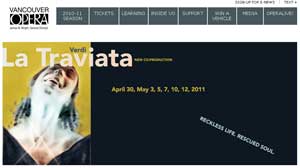
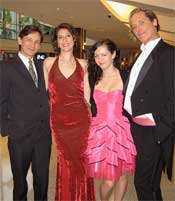
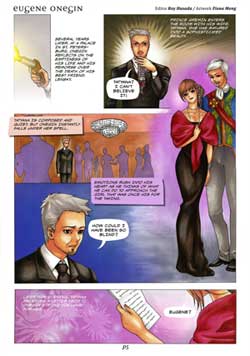
 As the Web & Social Media Assistant at the
As the Web & Social Media Assistant at the  L. Corwin Christie graduated from Oberlin College before moving to Denver and founding a theatrical production company. Her work in development and marketing inspired her to attend Carnegie Mellon University's Arts Management graduate program. She recently worked as the Social Media Assistant at the Center for Arts Management and Technology, and is the current Marketing Director of
L. Corwin Christie graduated from Oberlin College before moving to Denver and founding a theatrical production company. Her work in development and marketing inspired her to attend Carnegie Mellon University's Arts Management graduate program. She recently worked as the Social Media Assistant at the Center for Arts Management and Technology, and is the current Marketing Director of 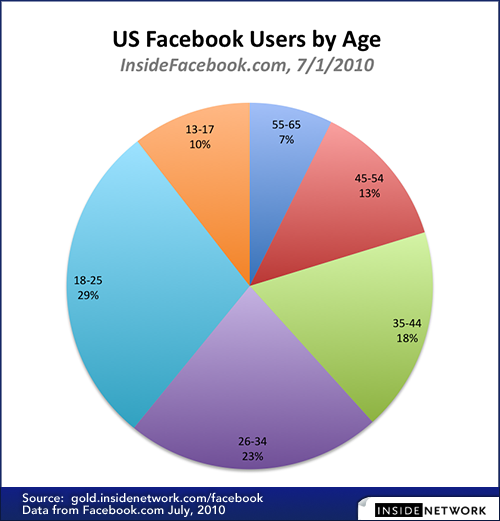 In 2010 educated adults over the age of 40 comprise the fastest growing demographic on Facebook, the age group 55+ grew by over 900%, and 40 million Facebook users in the US are now over the age of 40. This exposition of established professionals opens up the world of social networking even wider and begs the question: Are we properly using social media in the arts?
In 2010 educated adults over the age of 40 comprise the fastest growing demographic on Facebook, the age group 55+ grew by over 900%, and 40 million Facebook users in the US are now over the age of 40. This exposition of established professionals opens up the world of social networking even wider and begs the question: Are we properly using social media in the arts?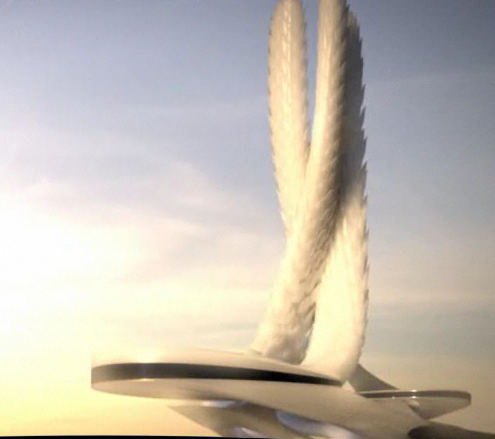 No guards. Always open. And I assume you won't have any
No guards. Always open. And I assume you won't have any 
